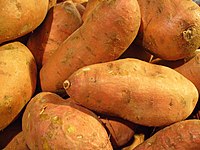
Photo from wikipedia
Abstract The cultivation technique and growth dynamics of purple-fleshed sweetpotato ( Ipomoea batatas [L.] Lam) have not been extensively addressed. The objectives of the present study were to explore the… Click to show full abstract
Abstract The cultivation technique and growth dynamics of purple-fleshed sweetpotato ( Ipomoea batatas [L.] Lam) have not been extensively addressed. The objectives of the present study were to explore the optimum cultivation conditions and growth characteristics of purple-fleshed sweetpotato Xuzishu 3, which is a new cultivar with high anthocyanin content, good germination and nice agronomic traits. Through the analysis of orthogonal experiments L 9 (3 4 ), the use of 300 kg/ha of K fertilizer, the planting 50,250 plants per hectare, and the growth for 120 DAT were regarded as optimum conditions for Xuzishu 3. The agronomic traits, qualitative characteristics and biomass accumulation of Xuzishu 3 during the six growth periods were measured to discuss the dynamic changes of its essential characteristics and yield accumulation. The main traits of Xuzishu 3 revealed sigmoidal or linear patterns during these growth periods. Most of the traits appeared as peak values after 90 DAT, except for anthocyanin, soluble sugar and protein content. Extremely significant positive correlations were found between dry matter rates of the up-ground parts (including leaf petioles, leaves and stems). Meanwhile, each of these had extremely significant positive correlations in terms of reducing sugar content and storage root weight per plant, respectively. Furthermore, the assimilated product distributed more in the stems and leaves than in storage roots before 90 DAT. Subsequently, the partition of assimilates to the storage roots rapidly increased and peaked at 135 DAT, even though the photosynthetic capacity and net assimilation rate decreased. The data and inferences in the present study not only improved the yield and quality of Xuzishu 3, but also provided a method to more precisely optimize the cultivation of purple-fleshed sweetpotato.
Journal Title: Field Crops Research
Year Published: 2018
Link to full text (if available)
Share on Social Media: Sign Up to like & get
recommendations!